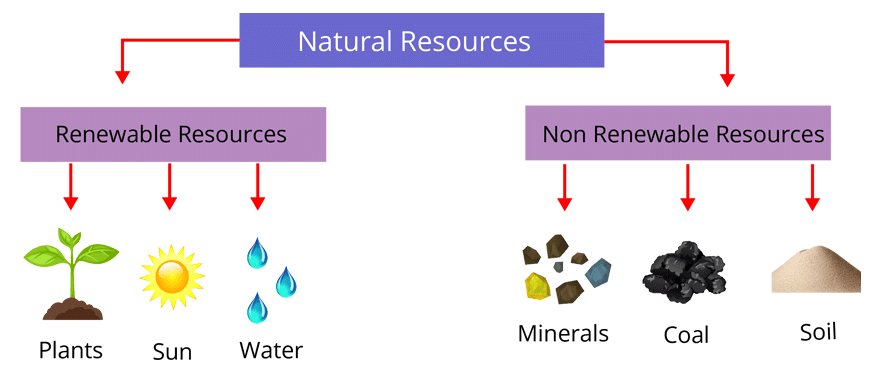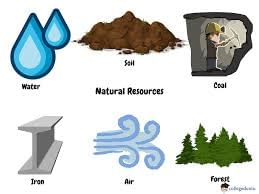Unit Test (Solutions): Resources | Social Studies (SST) Class 8 PDF Download
Time: 1 hour
M.M. 30
Attempt all questions.
Question numbers 1 to 5 carry 1 mark each.
Question numbers 6 to 8 carry 2 marks each.
Question numbers 9 to 11 carry 3 marks each.
Question numbers 12 & 13 carry 5 marks each.
Q1: Which of the following is a natural resource?
(i) Plastic
(ii) Petroleum
(iii) Iron ore
(iv) Both (ii) and (iii)
Ans: (iv) Both (ii) and (iii)
Petroleum and iron ore are natural resources as they are drawn from nature and used without much modification.
Q2: _________ is the process of using resources carefully and giving them time to get renewed.
Ans: Conservation
Conservation is the responsible management and use of natural resources to ensure they are available for future generations, allowing time for them to replenish and sustain ecological balance.
Q3: Which of the following does NOT make a substance a resource?
(i) Utility
(ii) Value
(iii) Quantity
(iv) Accessibility
Ans: (iii) Quantity
Quantity alone does not make a substance a resource; it must have utility and value.
Q4: Human resources are important because __________.
(i) They provide labor
(ii) They can create more resources with knowledge and skill
(iii) They consume resources
(iv) They are in large numbers
Ans: (ii) They can create more resources with knowledge and skill
Human resources use knowledge and skills to develop and enhance resources.
Q5: Renewable resources can be __________ quickly.
Ans: replenished
Renewable resources can be replenished quickly, meaning they can naturally regenerate or be restored over a short period of time, ensuring a continuous supply without depleting the resource.
Q6: What are non-renewable resources? Provide two examples.
Ans: Non-renewable resources are those that have a limited stock and cannot be replenished in a short period. Once exhausted, they cannot be used again within a human lifespan.
Examples: Coal and petroleum.
Q7: Explain the importance of human resources in resource development.
Ans: Human resources are vital because they possess the knowledge, skills, and technology needed to develop natural resources into useful forms. Their ability to innovate and discover new methods to utilize resources is crucial for sustainable development.
Q8: What is sustainable development, and why is it essential?
Ans: Sustainable development is the practice of using resources in a way that meets current needs without compromising the ability of future generations to meet theirs. It ensures that resources are available for the long term, balancing economic growth, environmental protection, and social well-being.
Q9: Differentiate between renewable and non-renewable resources.
Ans: 

Q10: Explain the role of technology in transforming substances into resources.
Ans: Technology plays a crucial role in resource transformation by enabling the conversion of raw materials into usable products. For example, iron ore is not directly usable until technology is applied to extract and refine the metal. Similarly, hydroelectric technology transforms water flow into electrical energy.
Q11: Discuss the significance of resource conservation.
Ans: Resource conservation is essential to ensure that resources remain available for future generations. By using resources judiciously, reducing wastage, and promoting recycling, we can prevent resource depletion and environmental degradation. Conservation helps in maintaining ecological balance and ensures sustainable development.
Q12: Describe the different types of resources with suitable examples.
Ans: Resources can be broadly classified into three types:
i) Natural Resources: These resources are directly obtained from nature and are used without significant modifications. They are essential for the survival of living beings and form the foundation of human life. Natural resources can be further classified into renewable and non-renewable resources, depending on their ability to replenish. Examples: Air, water, soil, minerals, and forests.
ii) Human-Made Resources: These are resources that humans create by transforming natural resources into useful products or infrastructure. Human-made resources play a crucial role in the development of society as they provide the necessary tools, structures, and technology that support economic activities. They are vital for the functioning of industries and urban development. Examples: Buildings, roads, machinery, and vehicles.
iii) Human Resources: Human resources refers to the skills, knowledge, abilities, and creativity of people that are utilized to develop and enhance other resources. This type of resource is crucial for innovation and the overall progress of society. Investing in human resources through education and training can lead to advancements in technology, healthcare, and various fields. Examples: Teachers, engineers, doctors, and scientists.
Q13: Explain the importance of sustainable development and list the principles of sustainable development.
Ans: Sustainable development is crucial for ensuring that the needs of the present are met without compromising the ability of future generations to meet their needs. It balances economic growth, environmental protection, and social well-being.
Principles of Sustainable Development:
i) Respect and care for all forms of life: This principle encourages the protection of wildlife and natural habitats, ensuring that human activities do not harm other species or disrupt ecological processes.
ii) Improve the quality of human life: The goal is to achieve economic growth and development that benefits everyone, especially marginalized communities, without compromising the ability of future generations to meet their own needs.
iii) Conserve the earth's vitality and diversity: This principle involves protecting the planet's natural systems, including forests, oceans, and biodiversity, which are essential for life on Earth.
iv) Minimize the depletion of natural resources: Sustainable development encourages the efficient use of natural resources, such as water, minerals, and fossil fuels, to prevent their exhaustion. By adopting practices like recycling, using renewable energy, and promoting energy efficiency, we can reduce our environmental footprint and ensure that resources are available for future generations.
v) Change personal attitudes and practices toward the environment: This principle advocates for environmental education, raising awareness about the impact of human activities on the planet, and encouraging sustainable practices such as reducing waste, conserving energy, and supporting eco-friendly products.
|
69 videos|431 docs|46 tests
|
FAQs on Unit Test (Solutions): Resources - Social Studies (SST) Class 8
| 1. What are the different types of resources? |  |
| 2. How do human activities impact natural resources? |  |
| 3. What is the importance of conserving resources? |  |
| 4. What are renewable and non-renewable resources? |  |
| 5. How can individuals contribute to resource conservation? |  |

















